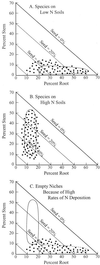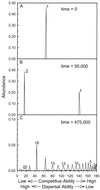Human-caused environmental change: impacts on plant diversity and evolution
- PMID: 11344290
- PMCID: PMC33230
- DOI: 10.1073/pnas.091093198
Human-caused environmental change: impacts on plant diversity and evolution
Abstract
Human-caused environmental changes are creating regional combinations of environmental conditions that, within the next 50 to 100 years, may fall outside the envelope within which many of the terrestrial plants of a region evolved. These environmental modifications might become a greater cause of global species extinction than direct habitat destruction. The environmental constraints undergoing human modification include levels of soil nitrogen, phosphorus, calcium and pH, atmospheric CO(2), herbivore, pathogen, and predator densities, disturbance regimes, and climate. Extinction would occur because the physiologies, morphologies, and life histories of plants limit each species to being a superior competitor for a particular combination of environmental constraints. Changes in these constraints would favor a few species that would competitively displace many other species from a region. In the long-term, the "weedy" taxa that became the dominants of the novel conditions imposed by global change should become the progenitors of a series of new species that are progressively less weedy and better adapted to the new conditions. The relative importance of evolutionary versus community ecology responses to global environmental change would depend on the extent of regional and local recruitment limitation, and on whether the suite of human-imposed constraints were novel just regionally or on continental or global scales.
Figures



References
-
- Vitousek P M. Ecology. 1994;75:1861–1876.
-
- Houghton J T, Meiro Filho L G, Callandar B A, Harris N, Kattenberg A, Maskell K. Climate Change 1995: The Science of Climate Change. Cambridge, U.K.: Cambridge Univ. Press; 1996.
-
- Pimm S L, Russell G J, Gittleman J L, Brooks T M. Science. 1995;269:347–350. - PubMed
-
- Vitousek P M, Mooney H A, Lubchenco J, Melillo J M. Science. 1997;277:494–499.
-
- Matson P A, Parton W J, Power A G, Swift M J. Science. 1997;277:504–509. - PubMed
Publication types
MeSH terms
LinkOut - more resources
Full Text Sources
Medical

